IV. HOUSING OF CATS
Texte und Bilder aus “THE BOOK OF THE CAT” von Frances Simpson aus dem Jahre 1903
THE BOOK OF THE CAT
CHAPTER IV
HOUSING OF CATS
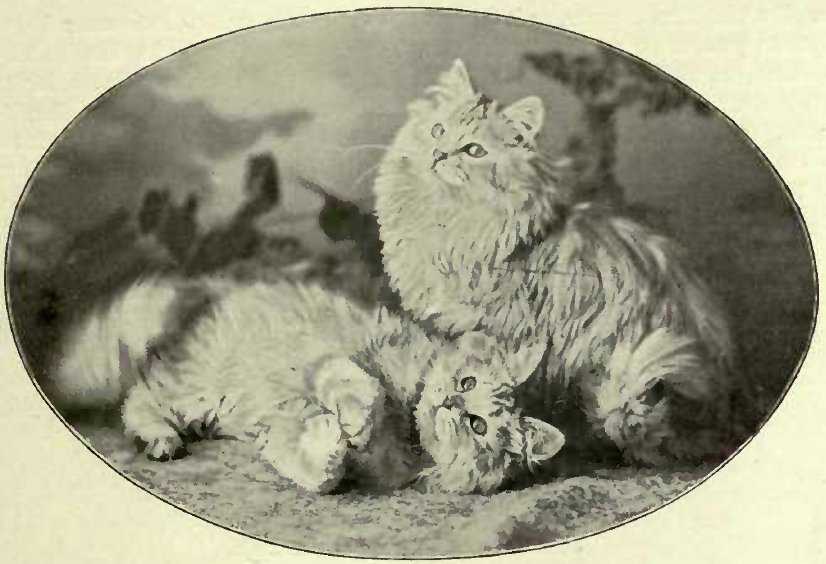
The proper housing of valuable stock is the first essential subject to be studied by the beginner in the cat fancy, and one requiring both careful thought and attention. For I do not hesitate to say that, of all the domestic animals, the cat is the most difficult to keep healthy and happy in the unnatural condition of total or partial confinement. Belonging to the ferae, its original and savage nature still shows glimpses, not wholly tamed, in its independence of character and its roving habits; while yet its civilised side shows the keenest appreciation of the comforts to be found in the home life. A house cat that enjoys its freedom to go out as it pleases, to climb the garden walls, and anon to lie in purring contentment before the kitchen hearth, is a creature ailing little. It is the pedigreed pets, in their luxurious prisons, that too often fall a prey to disease. To establish a cattery, therefore, that shall be a pleasure and a pride to the owner, and not a source of worry and grief over perpetual illness amongst the inmates, it is necessary in the very first inception to study the chief needs of cat nature.
Let us consider these in order. How our typical healthy cattery may be best arranged. It must be dry – was ever a cat yet seen of choice sitting in the wet? It must have ample space, both of houses and runs, and inducements for exercise – a well-branched dead tree sunk in the gravelled run is good, besides divers posts, shelves, and benches. Let the aspect be bright, with lots of sunshine. A cat is a devotee of the sun – it is the life of young growing things, and the greatest destroyer of disease germs; and it is very easy by coverings or the growth of climbing plants to provide temporary shade during the height of summer. For this last, nothing is better than that most useful and least fastidious king of climbers, the Virginian creeper, as it bestows its leafy shade just when required, and harbours no damp, as the growth of thick, tall trees is apt to do.
Lastly, let the outlook of the cattery be cheerful. Do not select a spot so far from the house life that the attendant who feeds and cleans is practically the only person the cats see in the twenty-four hours. A cat loves to observe, preferably from some secure high perch, whence it may see all that passes – to exchange greetings with the dogs, the gardener, the maids, the tradesmen coming to the door, and thus fill its imprisoned hours with interest. If you disregard this, and put your cats out of sight in some back yard, they will mope badly, and also grow very stupid.
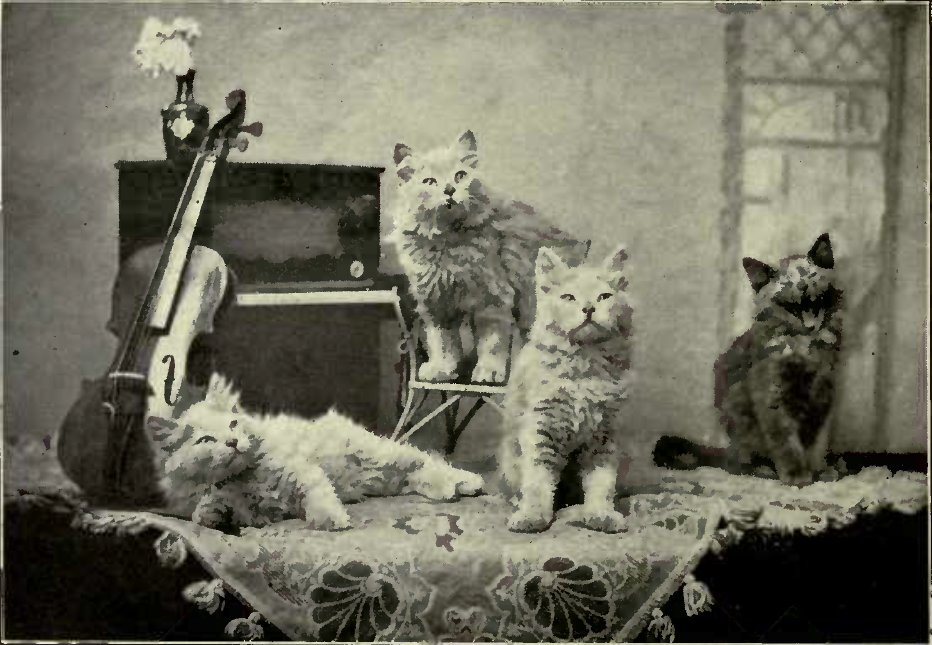
These principal requirements being borne in mind, individual fancy of building and arrangement may follow. Every breeder of experience has his own ideas of best design, according to means and circumstance. If a cat fancier is fortunate enough to be able to disregard expense, he can indulge in brick houses with every appliance for comfort and elegance of construction. For others, who can supply a working plan, an intelligent local carpenter (when found) can do much. Occasionally, also, it is possible to convert a portion of existing stabling to very efficient uses. But I must advise the beginner, as regards this last suggestion, to be careful. If the stabling is modern, and possesses the main requisites I have already spoken about (of dryness, and space, and cheerful light), then all is, and will be, well. But if, as is often the case, the stable of temptation is old, perhaps unused for some years, is dark, with more than a suspicion of damp, and a very certain habitat of rats, then our fancier is emphatically warned against making any trial of it, short of pulling down and rebuilding. Let him rest assured, it would in the end mean the loss of money, time, care, and, most likely, breeding stock too, and certain ill-health among the poor inmates.
I know a case in point where a cat fancier thus utilised a stable. A converted portion of old stabling that looked most desirable, and kept scrupulously clean, was used for a number of young kittens. Very soon a peculiar and most violent form of skin disease appeared amongst them, at first as mere scurfy patches, but swiftly assuming the form of contagious fever, which spread with frightful rapidity, infecting every cat with whom they came in contact. Not until after many deaths, and the most cruel sufferings of those who struggled through the disease, was it at last discovered to be acute blood poisoning, produced by the exhalation of sewer gas from an old sewer running underneath the floors. Rats were probably responsible, either by gnawing through the pipes, or coming up into the cattery, themselves stricken with the foul disease.
The site of the cattery selected, the preparation of the ground may be advisable, certainly on all clay soils. To ensure perfect dryness, the top soil should be removed a foot or so and filled in with brick rubble or builders‘ rubbish. On this foundation, cement concrete or asphalt may be laid down. Personally, for runs and floors, I prefer the cement; it is easier to keep clean – a bucket of water can swill it from end to end, while it dries much faster than the asphalt. Asphalt in outside runs is apt to soften in the summer sun, and depress into holes, and within the houses the smell of the tar remains strong for some months. The cost of the two is much about the same, but in very damp situations the asphalt is preferable, as it prevents all ground-damp rising through.
Now to plan out a medium-size cattery that shall be simple in construction and not ruinous to the modest beginner, let us suppose we have at our disposal a fair length of brick wall – say 60 to 70 feet in length – facing south, on slightly sloping ground. Our first proceeding will be to level and render damp-proof by a foot of rubble, as heretofore suggested, a strip 11 feet wide and about 45 feet along the wall, and to surface this strip with cement or asphalt. Upon this, and against the wall, we will erect our houses, a long wooden shed with lean-to roof, divided into three main divisions by matchboarding partitions, and with a smaller house at either end, as shown in plan.
A, the sleeping-room; B, a playroom for queens and kittens; and C, the third apartment for kittening, or cats it is desirable to isolate awhile. The smaller houses at the outside ends reserved for stud cats. D, doors from one apartment to another of wood. The outside woodwork is of 1-inch feather-edged matchboarding, well-seasoned deal, a roof of wood, felted and tarred, being preferable to the use of corrugated iron, which is very hot in summer and very cold in winter; an annual dressing of sand and tar keeps the felt watertight for many years. Allow good wide eaves, and have gutter pipes all round. Inside, line the walls with wall felt, and limewash; or an inner lining of 1-inch matchboarding, allowing a two-inch space to be packed with sawdust, keeps the house very warm and dry.
For the brick back wall, 1/4-inch matchboarding should be sufficient as lining. The dimensions of the sleeping-room, A, are 12 feet long by 11 feet wide, and a wire frame partition with door subdivides this again into two equal parts. ! Against the back wall, at a height of about 20 inches from the floor, runs a broad shelf 4 feet wide, having inch-mesh wire netting frontage, half to open on hinges, and movable wooden partitions sliding in a slot; these for the sleeping-pens, each 4 feet deep by 3 feet wide, two on either side the wire frame partition, or convertible into one 4 feet by 6 by removal of sliding wooden division. It will be warmer for the occupants if these pens are roofed in at a height of 3 feet. Cover the bench with oilcloth before putting up the divisions. This can be washed over daily if necessary, and will dry in a few moments, thus avoiding the dangers of scrubbing wood in damp weather. As nothing offensive can soak in, a pure atmosphere is preserved, and risk of infection is greatly minimised.
A comfortable sleeping box or basket should be provided for each pen, filled in winter with plenty of sweet hay, and in summer with sheets of newspaper or brown paper. A cat loves to repose on paper, and it has the advantage of being cheaply renewable and easily burnt after a day or two’s use. Never use old packing straw for bedding. It is frequently full of infectious germs, and many skin complaints have been traced to its use. Neither are cushions, blankets, old bits of carpet, matting, etc., to be recommended. They are apt to become damp in prolonged wet weather, and retain both dirt and odour. A sanitary tin to hold dry earth or sawdust should be placed in each cat house, emptied and washed out every morning by the attendant, when the floors are also swept out or washed over.
A fair-sized window, to open, must be in the front, and a door, the upper half of which might also be of glass, to open out into a gravel run. Outside wooden shutters for cold nights are a great help in keeping the house warm, and should be provided.
Having arranged our first room, the playing room, B, next must come under consideration. This being the central division, the felt lining could here be dispensed with, and instead the boards can either be plainly stained and varnished – which is also easy to keep perfectly clean – or Willesden damp-proof paper might be nailed over the walls. This paper, made at the Willesden Company’s works, Willesden Junction, N. W., is made in several good colours for interior lining, and a house so hung looks very comfortable, and shows to advantage such mural decorations as show prize cards, photos of winners, etc. The frontage of this room is to be entirely glazed, in small panes set in a wooden framework, with a 6-inch high weather board at floor to protect from draughts, the glass protected on the inside by wire netting fastened over it. A window here to open outwards with a bolt, and fairly high up, to ensure fresh air in rainy weather without the wet and damp driving in on a level with the cats; a half-glass door also to run, but no outside shutters will be here needed, the cats not occupying this room at night.
Cover the asphalt floor with linoleum or oilcloth, and put up some shelves 15 inches wide, fairly high up, but within leaping distance, against the walls; a movable bench too, to place the cats upon for brushing and attending to them. Old chairs that can be spared from the house might end their service here; or if the luxury of a plain wicker chair could be permitted, and furnished with one or two cushions in washable slip covers, it would be as pleasant for the owner when making her visits as for the pussies themselves. A ball for the kittens, a reel hanging from a string, will stimulate healthy romps, even amongst the staid grown-up cats, when weary of indoor dozing.
Room C is primarily intended for the interesting occasions when new little prizewinners are expected. This is subdivided by wire as in sleeping-room, but the partition three feet from back wall should be of wood, to ensure privacy to the anxious mother, and to temper the light; oilcloth on floor.
For the littering nests themselves I describe, and advise my friends to make trial of, the following plan. Have a sort of shallow wooden box, or tray with sides, made about 4 feet 6 inches long by 24 inches high and 4-inch sides. This is stained, varnished, and mounted on wooden feet at the four corners about two inches high; a good bed of hay is put in it, the box is put in a quiet corner away from the light, and a truss of new straw placed upright at one end of the box, leaning against the angle of the wall. A little of the straw at the bottom may be pulled out to suggest the idea of a hole to the cat; but as a rule she takes to the notion brilliantly, and will set to work to dig out a nest for herself with the greatest zest. In this the kittens are born, safe in a cosy nest at the end of a tunnel of straw. There is ample ventilation; they are protected from all draughts, so that doors may be left open to the fresh air with impunity; and they are in the dark, as kittens naturally should be till they walk out into the daylight of their own desire to explore the world.
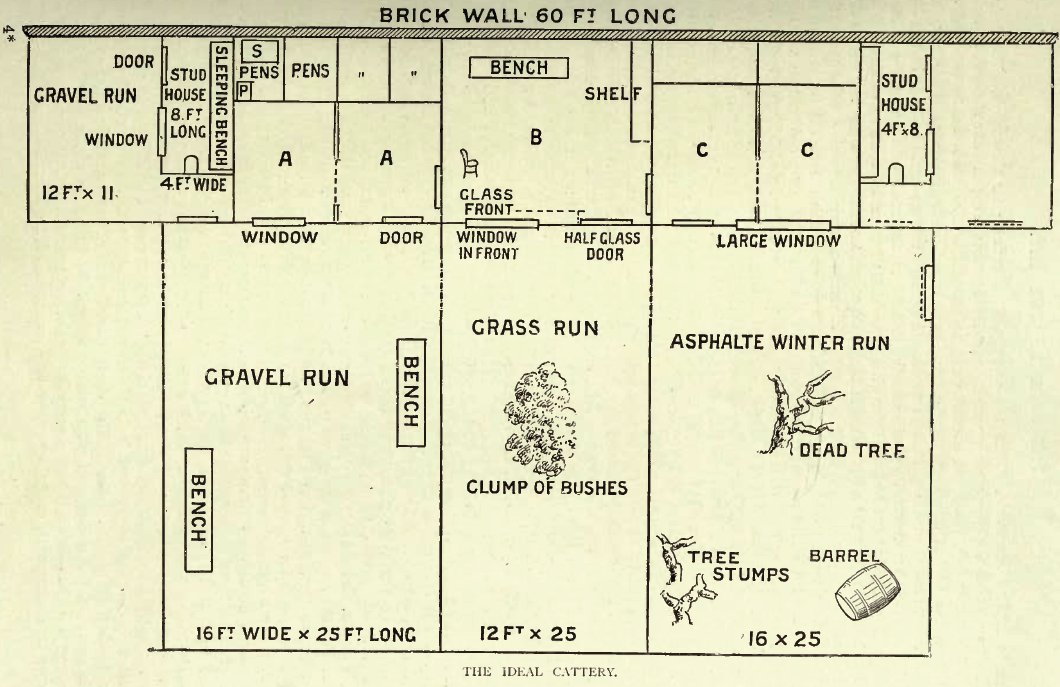
Then the rest of the tray forms a glorious playground for the first week or two, when one adventurous mite finds out he can climb up the shallow sides, and tumble out on a large strange world of floor and trot after mamma. A well-known fancier tells me she has not had one litter with weak or bad eyes since she adopted the straw truss plan.
The Ideal Cattery
One of these trays might be placed each side of the wooden partition, and if necessary to shut a nervous or surly cat up with her family, one might be enclosed in a wire frontage with door, as the sleeping-pens were arranged. Let there be a good large window in this room, as the kittens, when running about, will want all the sunshine and air possible. This run should be of asphalt, for dryness and warmth, with plenty of play places arranged in it. An old barrel with the bottom knocked out affords great games, also the tree I have before spoken of; a tree-stump or two, or a heap of dry brushwood stacked in a corner, will supply those climbing and hiding holes kittens so greatly enjoy, and afford protection from winds.
A grass run and a gravelled one are designed in the plan, each having access to the other, and will allow the cats ample exercising ground according to weather. An oval flower-bed in the centre of the grass plot, planted with some evergreen bushes, is a good idea. It affords shelter, and the cats can dig in the dry earth. For the benches in the gravel run, an old outhouse door, painted and mounted on stout legs, makes a very good one, which the cats love to sit upon.
The stud houses are simple: a wired-in space of 12 feet by 11 feet contains a house with lean-to roof 4 feet by 8 feet long, fitted with sleeping bench and box, wired windows, door for attendant, and small trapdoor for cat. En passant, all doors should be fitted with good locks, and locked up after feeding at night is done. The stud run is gravelled, but a border of grass might be left on two sides – grass is such a necessity for cats in confinement, and they prefer to select it growing for themselves. The design here suggested is capable of either modification or extension. The plan can be enlarged to any extent. For instance, if desired, an attendant’s cottage could be built at one end instead of the stud house, and comprise a special kitchen, and also an upper room, fitted with convenient pens for a hospital for the sick members – a very necessary adjunct to the cattery, as a sick cat should be at once removed from its healthy companions and kept in a place quite apart. More stud houses could be arranged at an angle on one side of the chief runs, or, if only a very few cats are intended to be kept, one of the divisions could be dispensed with, perhaps, and the dimensions of the other two made smaller.
But whatever your ambitions may be, great or small, when you are about it have the work well done.
The heating of catteries is a rather vexed question, many famous breeders affirming that stock raised without it are healthier and harder; others maintaining that a certain amount of heat is a necessity for producing a good coat. A very experienced breeder once told me the heaviest-coated kittens she ever bred were reared over some hot-water pipes, in a temperature of 700! With adult cats having partial freedom and allowed to come into the house in severe weather, and with stud cats, I consider the no-heat plan decidedly the best; but I do not think it possible to rear young stock during the colder part of the year in an outdoor cattery without artificial heat. It is the damp of the English winter which proves so fatal, and damp cannot be kept out of the very best constructed houses except by the admission of dry heat.
Kittens that are cold will not play, and if you see them huddled together on a cold day looking listless and uneasy, instead of romping, be sure it is fire heat they need.
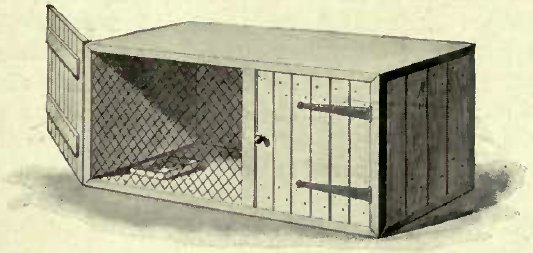
A thermometer should hang in each house, and the heat be carefully regulated by that, a minimum of 480 and a maximum of 550 being suggested. In houses where a flue is practicable, a stove of the Tortoise pattern is to be recommended, but it needs a high guard around it. For a long range of brick-built houses, an outside flue and boiler, with hot-water pipes running the length of the cattery, would be found of most service, as it maintains an even and medium warmth throughout, keeps the building perfectly dry, and can be stoked with less trouble. In small wooden houses, very excellent results are given by the use of an oil stove with hot-water apparatus, such as a re supplied for small greenhouses. The lamp will usually burn twenty-four hours without attention, is un-get-at-able by the cats, who can neither singe their tails nor knock it over during the wildest gambols, and if kept clean and looked to with care will not cause the slightest odour. A quart of paraffin in one of these oil stoves will burn twenty – four hours, and heat a building 12 feet by 10 feet to 50°. Now, in concluding this little discourse upon catteries, the final word of advice is always to remember the importance of absolute cleanliness.
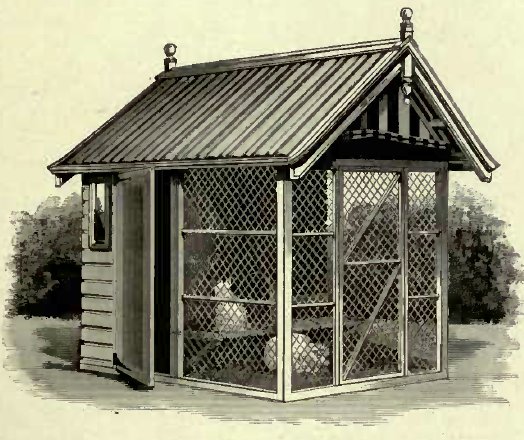
There should never be the least offensive smell in the cattery, and if such be noticed on entering the houses in the morning, discover the cause and remedy it at once. And do not rely solely upon disinfectants to do this. Too frequently this is but overcoming a bad smell by a stronger, the evil remaining. A good and non-injurious disinfectant should always be used in the water for the daily cleansing of pans and floors, etc. Camphaleyne or Salubrene are both safe and effective, but disinfectants that contain creosote in any quantity, or carbolic, I do not approve of, except in cases of illness of an infectious type, when stronger measures are obligatory.
No dirty food dishes, no unchanged water, no soil of any kind, should ever be left about on flooring or bedding. Let your cattery be kept as scrupulously clean and sweet as a hospital, then will your cats thrive and kittens be healthy and sturdy.
Do not elect to start a cattery unless you yourself intend to bestow both time and trouble upon it. In this, as in every other occupation or hobby, the one golden rule is, „Whatsoever thy hand findeth to do, do it with all thy might.“
Cat Appliances
In the preceding section on the cattery proper, I have not spoken of the very useful variety of portable houses which are now made a speciality of many firms, considering them more or less as accessories to the well appointed cattery. But in small town gardens, where space is valuable and it is not convenient to build a large permanent structure, it is quite possible to succeed extremely well when two or three cats only are kept by using these portable houses. They also have the advantage of being removable and a „tenant’s fixture“ in the event of leaving one’s house. A very good house is one built by Messrs. Boulton and Paul, of Norwich (sec illustration). It is a very pretty and well designed structure, and would be exceedingly ornamental in a sheltered corner of the garden. In putting up, however, it should be stood upon brick piers to raise it at least four inches from the ground, or the wooden flooring would soon show damp. Cats kept in these small houses, it must be understood, should have their liberty at least a portion of every fine and dry day, the runs being wholly inadequate for a cat to be shut in continuously without further scope for exercise.
Another illustration is a handy portable hutch, intended to be used chiefly in a house or room, although it is also convenient for penning young kittens out-of-doors on a sunny day. the wire run preventing their straying away. It consists of a sleeping-box and small wire run hooked on, and can be made at the cost of a few shillings.
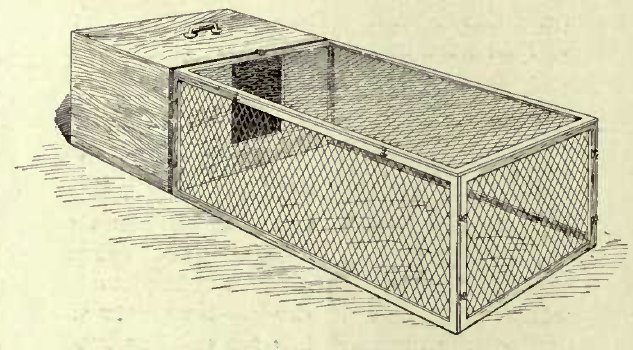
The sleeping-box is 24 inches long by 17 inches wide and 22 inches high, is raised three inches from floor by a false bottom, and has a large door at back opening with a brass catch. In front, two side-pieces reduce the entry to 12 inches. A handle screwed on the top of the box is convenient for carrying. The run is 3 feet 6 inches by 24 inches-, made in four sections, two sides, top and end piece, all fitted and hooked together with 1-inch mesh wire netting that it may be easily taken apart for carrying or storing away. It makes a useful sleeping-pen, too, for young toms that are inclined to quarrel together, and so have to be shut up separately at night. All the woodwork is stained and varnished, and a square of oilcloth laid on the floor of the sleeping-box.
The next appliance to be considered is a somewhat gruesome adjunct to the cattery, and belongs to the darker side of our hobby. In spite of every care, illness and death must enter now and again, when we are fain to retire worsted from the conflict with disease, and the wisest and kindest thing to do is to put our pet to sleep. The illustration given on the opposite page depicts a lethal box, as used at the Royal London Institution for Lost and Starving Cats at Camden Town, and is capable of holding twelve animals at a time.
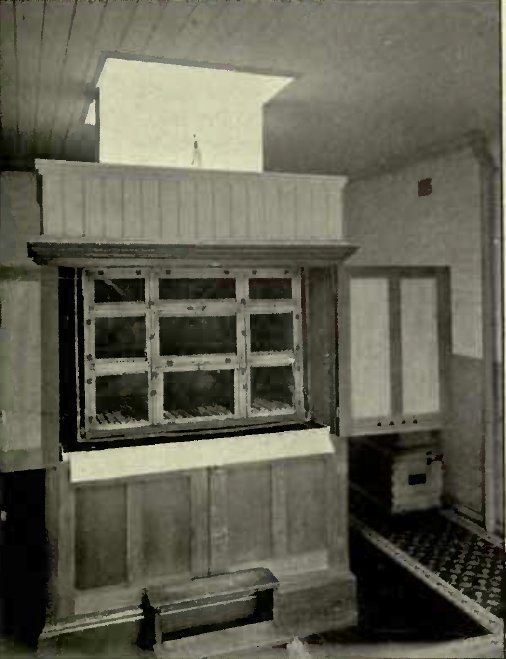
Mr. Ward, the well-known feline specialist of Manchester, has patented a lethal box of more moderate dimensions. Mr. Ward, not yet having an illustration of it, kindly writes me the description as follows: – „The box inside is 15 inches by 12 inches by 12 inches. A sheet of glass is inserted in the lid, so that the operator may watch the process. The vapour – coal gas passed through chloroform – enters through a tube at end. Two minutes is sufficient time.“ Fanciers, I think, will agree that this simple peace-giving box is not among the least of Mr. Ward’s kindly ministrations to the cats he loves so well. Few amongst us can bear to see unmoved the terrible last pains of a pet who in its days of health delighted us with its beauty.
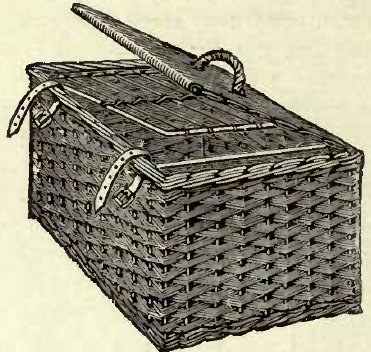
Feeding utensils we turn to next. For them nothing is more satisfactory than the unbreakable enamelled ware in white or blue – except, perhaps, for the water pans, for which it is scarcely weighty enough, and it not infrequently happens that a gay and frolicsome company of kittens will knock against them, sending them spinning, and the water is spilt upon the floor.
The circular, heavy glazed earthenware dishes, spittoon-shaped, and generally inscribed „Pussy,“ are excellent, and cannot be overturned.
Besides the plates and saucers for feeding, let the cats have also a saucepan of their own, a deep stewpan-shaped one, of blue enamel, large enough to cook a sheep’s head with biscuits. Cook will be far less prone to grumble at the necessary cooking for the cats – I speak here of a small cattery, when no attendant is kept – if her saucepans are not pressed into the service.
But see that all are kept scrupulously clean, nothing „left over“ in the saucepan to become sour or tainted in hot weather; and after each meal is cooked, the saucepan should be boiled out with soda and scoured clean.
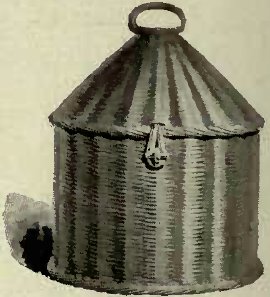
Earth tins. A great mistake made in these necessary items is having them too deep. I have seen an old zinc footbath supplied to two months old kittens with quite six inches of sawdust in it, and the owner wondered why she could not teach her kittens to be cleanly in their habits !
A 4 inch deep tray is quite deep enough, and this should not be filled more than two thirds full, or the cat rakes so much earth out on the floor. Neither do they require to be very large, as their weight when filled with soil makes them very cumbersome to move, and they get the more quickly knocked out of shape. The best size is about 17 inches by 14 inches and 4 inches deep, made in stout galvanised iron, with a rim round the edge, and these might be painted some light colour with Aspinall’s enamel paint. (I advocate „light paint.“ as any dirt stains are seen at once.) They will then last free from rust, and can be washed out every morning. Two or three tins of smaller size – say, 12 inches by 8 inches by 2 V inches – are suggested for kittens, or for placing in small pens in an emergency. Baking tins answer this purpose.
After washing, it is well to stand these trays in the air to sweeten, as if they smell disagreeable the cats will not use them. Messrs Whiteley supply these zinc tins, or they can be made by any local ironmonger to dimensions given.
Hot-Water Appliances
These are very necessary in the cattery, and should by no means be forgotten.
Many a sick cat’s life has been saved, and the critical corner in an illness turned, by the timely comfort and strength bestowed by the hot-water bottle or bag, or even a brick made hot in the oven and wrapped up. In the event of winter litters, too, a hot-water bag should be always in readiness, in case it is advisable to remove the first-born kittens from the mother for a few hours. Heat will restore a seemingly dead kitten, as I have said before. The outside dwellers also, how they appreciate on a bitter winter’s night the hot bottle or wrapped up hot brick to keep them cosy!
I know a luxurious stud cat who has a hot-water tin made to fit his sleeping box, which is filled by the maid every cold night and slid beneath his hay bed. Assuredly, there is no greater safeguard against winter’s chills and changes of temperature than to provide for your pets sleeping warmly and comfortably at night. The hot-bottle plan has many advantages over the heating of the sleeping houses by stove or lamp during the night. It is better for the animals themselves, as the air is not exhausted, and they are not so prone to take a chill going from heated air to the outside rawness of a w i n t e. r’s morning. It is much safer, and it is also much more economical. Personally I prefer the indiarubber bag to the old-fashioned stone bottle, and in the smaller sizes (which are quite large enough) are not much more expensive than the latter. If not filled too full, and wrapped in a washable cover – flannelette is very good – it can be laid flat under the hay, and the cat will remain upon it all night.
In the case of a sick cat the cover should always be of flannel, to avoid any chill as the bag grows colder.
Then, in our list of appliances, proper travelling baskets must come under consideration. I say „proper“ advisedly, for how heterogeneous is the collection of hampers, boxes, baskets – I had almost added bundles – one sees brought in by the officials during the receiving hours before a big show ! Every variety of package, very many of which are exactly what they ought not to be. Some unnecessarily elaborate, polished wooden cases with brass fittings – handsome and durable no doubt, but far too cumbersome, and by their very weight inflicting much jar on the occupant when moved about; while others are a disgrace to anyone pretending to care about a cat or even to know what a cat is, many deserving to be straightway brought under the notice of the Society for the Prevention of Cruelty to Animals.
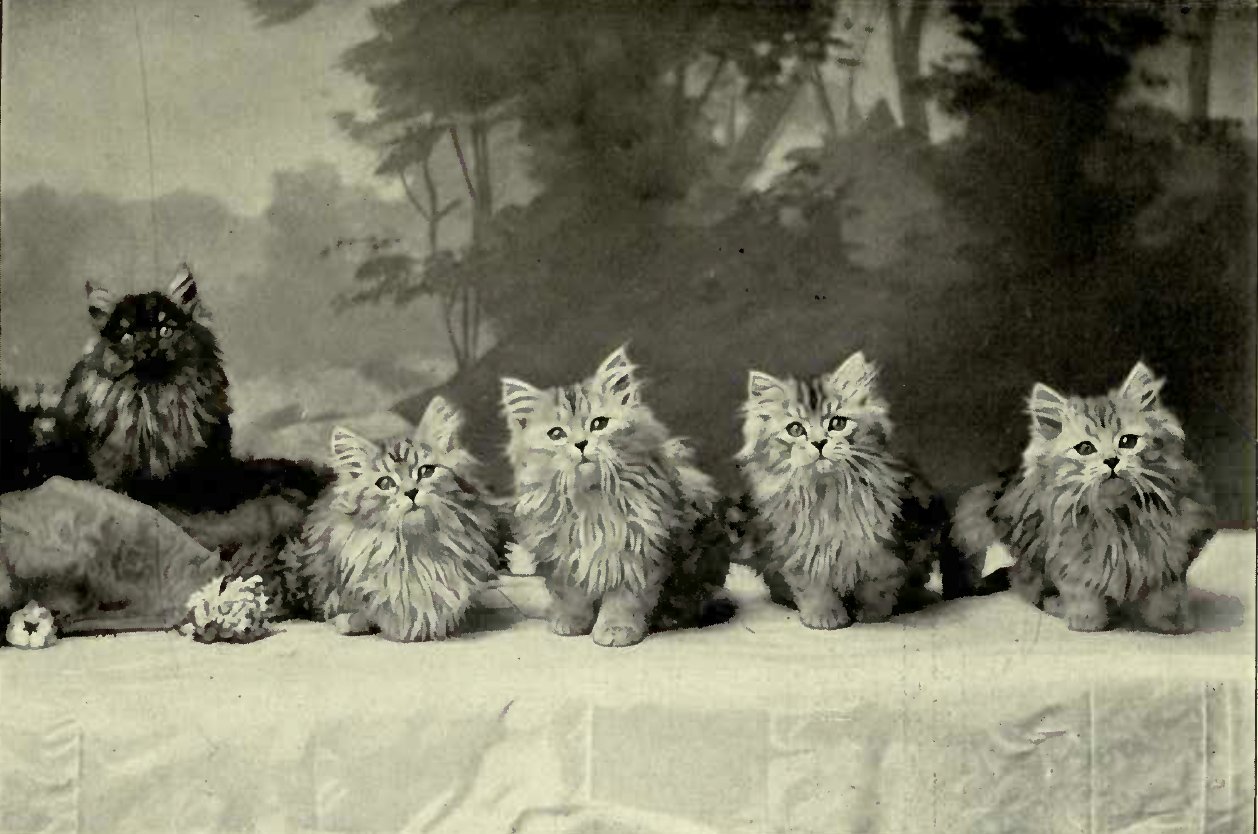
I have seen big heavy cats jammed into margarine hampers, a thin wicker receptacle whose sides slope inwards like a flower-pot, where the animal must have suffered agonies of cramp in a veritable chamber of „little ease.“ Others are sent weary distances in shallow, rough grocery boxes with a few holes bored for ventilation, subject to be thrown about in transit, first on one side then on the other, the lid perchance nailed on, giving thereby much extra trouble to the penning officials. Little wonder if the cat arrives bruised, shaken, frightened nearly to death, and very probably wild and savage.
Now, as evil is wrought by want of thought (and common sense) as well as want of heart, I have thought it well to comment on these very wrong and stupid ways of sending our cats on their journeys before advising better arrangements.
Here are two illustrations of excellent travelling baskets, which fulfil pretty nearly all requirements for cats travelling singly.
The first is made by Messrs. Spratt, and has an inner skeleton lid, which is much to be recommended when sending a vicious or very timid cat that is likely to make a bolt on the basket being opened.
The second, beehive shaped, is designed by Mrs. Paul Hardy, of Chobham. It is of strong white wicker, the lid fastening with a rim of about two inches deep over the body of the basket, apertures in the rim allowing the wicker loops of the fastenings to project; when the cane stick is thrust through these the basket is absolutely secure – not a paw can get out.
This beehive shape has several advantages. The cat can stand up and stretch itself at ease, when tired of lying down. The handle being at the apex, it is carried – even by porters – without the cat being tilted off its legs; whilst the dome top prevents any other package being piled upon it – a disadvantage the flat-typed hamper always has. I line my baskets outside with brown paper or oil baize up to the rim, and inside with curtain serge, leaving the lid free for ventilation. Then, with plenty of hay at the bottom of the basket, the cat will travel from one end of England to the other in comfort and safety, with no danger of taking cold even if left about draughty platforms or in parcel offices. This basket is made by Messrs. Bull, of Guildford, at a very moderate cost, and lasts for years.
These baskets are, of course, intended for one cat only, or a pair of kittens. A really safe and capable travelling arrangement for a litter with the mother has yet, I think, to be devised. I have seen none I think good. The double compartment hamper I much dislike. The handles are perforce at each end, necessitating two carriers – who never do it – so the hamper is dragged by the porter or official with one end tilted (the other cat being nearly upside down), is leant up against other luggage, or dropped flat with a bang. With young kittens inside this leads to fatalities.
A label for the travelling basket seems an insignificant item to mention, but an efficient one is as important as that proverbial nail for whose absence the horse and the kingdom were lost.
I have just made the acquaintance of a first-rate label, devised and sent out by a Mr. Foalstone. at sixpence per dozen, from the Aerefair Engineering Works, near Ruabon. It is a stout linen label, printed „Valuable Live Cat“ in big block letters; below is „Urgent“ in red – a good idea, red being more likely to attract the casual eye of the railway official. Spaces are left below for line of travel, via, etc., and date and time of despatch. It is reversible, so the sender can fill up with the return address if necessary. I always prefer to fasten the label down at both ends, flat to the basket: it is less likely to be torn away than when left hanging loose from one eyelet.
It is by due attention to the details that cat fanciers can to some extent mitigate the dangers and risks that must necessarily attend the transit of live stock by rail.
